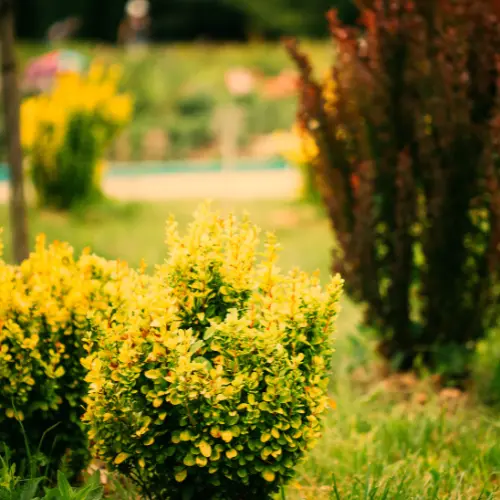Invasive Plants, Mice, and Ticks: The Japanese Barberry Problem in Vermont

When people think of pests like mice and ticks, plants aren’t usually the first thing that comes to mind. Yet in Vermont, researchers have noticed a strong link between the rise of invasive shrubs, especially Japanese barberry (Berberis thunbergii), and growing populations of rodents and ticks. These thorny bushes not only displace native plants but also create the perfect habitat for mice and ticks to thrive. Understanding how barberry contributes to this problem can help landowners and residents reduce the risk of tick-borne illnesses.
Japanese Barberry: A Thorny Invader
Originally introduced from Asia in the late 1800s for ornamental use, Japanese barberry soon escaped gardens and spread throughout the Northeast (Vermont Fish & Wildlife Department, 2021). Known for its small oval leaves, bright red berries, and sharp spines, this versatile shrub grows in sun or shade and forms dense thickets that outcompete native vegetation. Deer avoid its prickly branches, giving it an even greater advantage over other plants.
Williams et al. (2009) found that barberry stands trap moisture under their thick foliage, creating a humid microclimate. Ticks, especially blacklegged ticks (Ixodes scapularis), thrive in such moist conditions because it helps them stay active longer, increasing their chances of attaching to a host. When infestations of barberry are cleared, studies show a marked drop in tick numbers.
A Safe Haven for Mice
Deer mice and white-footed mice are the primary carriers of the bacteria that cause Lyme disease (Vermont Department of Health, 2022). Young ticks feed on these rodents, pick up the infection, and later pass it to humans or pets. Thick barberry patches offer mice shelter from predators like hawks, foxes, and owls, giving rodents a chance to reproduce more. As mouse numbers climb, so do opportunities for ticks to feed and become infected.
Other Invasive Plants
While barberry is a major culprit, other non-native shrubs, like bush honeysuckles (Lonicera spp.) and common buckthorn (Rhamnus cathartica), also increase mouse and tick activity (Northern Woodlands, 2019). These species form the same shady, humid undergrowth that ticks and rodents favor. The result is a wider problem of invasives boosting pest risks.
Impact on Public Health
Vermont consistently reports high rates of Lyme disease (Vermont Department of Health, 2022). This makes sense when you consider that more rodents and more ticks mean greater chances for people to encounter infected ticks. Pets are also at risk, often bringing ticks into homes where they may bite humans. Reducing these invasive shrubs can help lower tick populations, thereby decreasing the likelihood of Lyme and other tick-borne illnesses.
Management Strategies
Fortunately, there are ways to tackle barberry and limit its impact on mice and ticks:
Physical Removal
Pull or dig up smaller shrubs, ensuring the entire root is removed. Properly dispose of the plants to prevent seeds from spreading.Selective Herbicides
For extensive infestations, consider carefully applied herbicides. Consult professionals when dealing with large areas or sensitive habitats.Replant with Natives
After removal, introduce native shrubs and groundcovers. This helps restore biodiversity and avoids the damp conditions that favor ticks.Landscape Maintenance
Mow grass, rake leaf litter, and thin out brushy spots around the home. Fewer hiding places mean fewer rodents.Personal Protection
Wear long sleeves and pants, use tick repellents, and check yourself and pets thoroughly after outdoor activities.
The Payoff
Studies show that controlling barberry can significantly reduce local tick populations (Williams et al., 2009). Over time, this lowers Lyme disease risks and supports healthier, more diverse plant and animal communities. Although barberry seeds can persist in soil for years, consistent efforts by landowners, communities, and conservation groups can keep these invasive shrubs in check.
By recognizing how Japanese barberry contributes to the mouse and tick problem, Vermonters can make informed choices about land management and personal precautions. A mix of removing invasive plants, encouraging native species, and practicing proper tick awareness offers a real chance to cut down on tick encounters. As these unwanted shrubs are cleared, forests and fields can bounce back to support native wildlife and reduce pest threats for everyone.
References
Gardner, A. M., Hamer, S. A., & Hamer, G. L. (2013). Assessing the influence of invasive shrubs on ticks in Maine, U.S.A. Journal of Vector Ecology, 38(2), 333–342.
Northern Woodlands. (2019). Invasive plants in northern New England. Northern Woodlands Magazine, 25(4), 8–15.
Vermont Department of Health. (2022). 2022 Tickborne diseases in Vermont annual report. Burlington, VT: VDH.
Vermont Fish & Wildlife Department. (2021). Guide to invasive plants in Vermont. Montpelier, VT: Vermont Fish & Wildlife Department.
Williams, S. C., Ward, J. S., Worthley, T. E., & Stafford, K. C. (2009). Managing Japanese barberry (Berberis thunbergii) infestations reduces blacklegged tick (Ixodes scapularis) abundance and infection prevalence with Borrelia burgdorferi. Environmental Entomology, 38(4), 977–984.